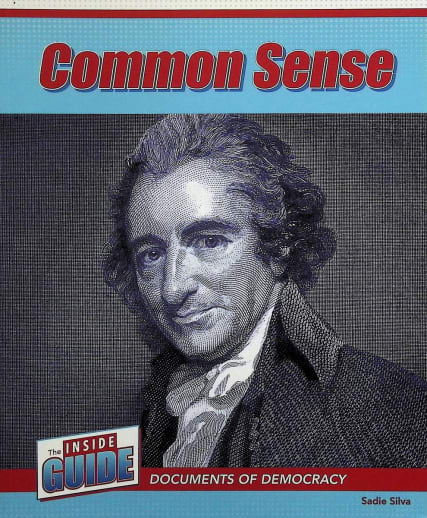When a war for freedom is raging, soldiers need words to inspire. Thomas Paine wrote many words that inspired and lit the fires of revolution. As an English man who sailed to the colonies as war started, he presented a unique perspective that the colonists related to. Not everyone agreed with the sentiments Paine expressed. However, many of these opinions became rousing words to the Founding Fathers as they drafted our nation’s founding documents. Direct quotes from Paine’s Common Sense can be found in the back along with a glossary of noted vocabulary words. Fast Facts litter the pages with interesting and fun information. Pgs. 32, sc. ~Rebecca
Common Sense (Inside Guide: Documents of Democracy)
SKU
045539
ISBN
9781502660466
Grade 4-6
These icons are designed to help you quickly understand and learn important information about our products.
Teaching Method
Traditional
Teacher-centered curriculum commonly used in classrooms that may include a text, teacher manual, tests, etc.
Charlotte Mason
A methodology based on the work of a 19th century educator who maintained that children learn best from literature (Living Books), not textbooks.
Classical
A methodology based on the Latin Trivium (three stages of learning), including the grammar stage (memorization and facts), logic stage (critical thinking), and rhetoric stage (developing/defending ideas).
Unit Study
A thematic or topical approach centered around one topic that integrates multiple subject areas.
Montessori (Discovery)
A methodology based on the work of a 20th century educator that emphasizes student and sensory-driven discovery learning and real-life applications.
Other
Other methodologies
Religious Content
Secular
Contains content contrary to common Christian beliefs (i.e. evolution).
Neutral
Avoids religious or theoretical topics or presents multiple viewpoints without preference.
Christian/Religious
Faith-based or including instructional religious content.
Learning Modality
Auditory
Learns through listening, talking out loud or reading out loud.
Visual
Learns through seeing, prefers written instructions and visual materials.
Kinesthetic/Tactile (Hands-On)
Learns through moving, doing and touching.
Multi-Sensory
Curriculum that employ a variety of activities/components.
Presentation
Sequential
Curriculum progresses through well-defined learning objectives. Emphasizes mastery before moving to the next topic.
Spiral
Topics and concepts are repeated from level to level, adding more depth at each pass and connecting with review.
Conceptual/Topical
Focus is on the “why,” often with a unifying concept as well as specific skills; coverage may be broader.
Teacher Involvement
Low Teacher Involvement
Student-led materials; parent acts as a facilitator.
Medium Teacher Involvement
A mix of teacher-led time and independent student work.
High Teacher Involvement
Teacher-led lessons; may utilize discussions, hands-on activities and working together.
Additional Materials Required
No other materials needed
Everything you need is included.
Other Materials Required
There are additional required resources that are a separate purchase.
Other Materials Optional
There are additional resources mentioned or recommended but are not absolutely necessary.
Consumable
Consumable
Designed to be written in; not reusable.
Non-Consumable
Not designed to be written in; reusable.
Our Price
$11.58 $11.58 $8.75
Rainbow Savings: $2.83
Product Overview
- One of the most important documents of the Revolutionary War!
- These quick reads include Fast Facts about historical documents for elementary students
- Wonderful pictures and maps help students visualize history
Description
Publisher's Description of Common Sense (Inside Guide: Documents of Democracy)
Many Americans are unfamiliar with Thomas Paine's pamphlet, Common
Sense. However, at the time it was written, it was one of the most
important documents in what is now the United States. Paine's challenge
to the British government's authority, written in language all Americans
could understand, helped fan the flames of revolution. Like Paine's
pamphlet, this volume uses accessible language, explaining what's in
Common Sense and why it changed the course of history. Eye-catching
photographs and engaging sidebars bring the document to life, immersing
readers in the revolutionary era. In addition, critical-thinking
questions help readers dive deeper into this topic.
Category Description for Inside Guide: Documents of Democracy
Introduce young readers to the documents that laid the bedrock for this nation. Some documents may surprise you, as you will learn about the Mayflower Compact and the Magna Carta. These brief readers introduce great vocabulary, timelines, classical artwork, and critical thinking discussion questions, and would make a great unit study (especially during an election year). There are factoids on people, places, and events throughout the pages that are easy to engage with and will stick in little minds. Nonfiction readers like these open students to further research and can lead students to interest-based learning during your school year. ~Rebecca
Details
| Product Format: | Paperback |
|---|---|
| Grades: | 4-6 |
| Brand: | Cavendish Square |
| ISBN: | 9781502660466 |
| Length in Inches: | 8.5 |
| Width in Inches: | 7 |
| Height in Inches: | 0.125 |
| Weight in Pounds: | 0.2 |
Videos
Reviews

